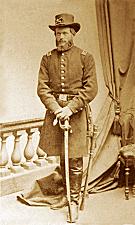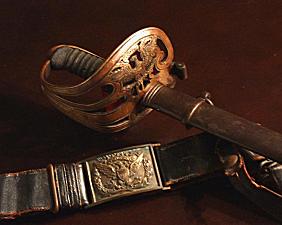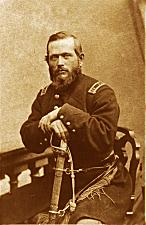J. Sewall Reed
"…all of a sudden it became a
hand-to-hand affair. It was soon evident to Reed that he was in for a whipping,
and his men began breaking through the fences and into the field, but fighting
all the while. His Californians, especially notoriously good fighters, were
standing up to the rack like men, dealing out to us the best they had. They
rallied at every call on them and went down with banners flying." ---John
W. Munson, from Reminiscences of a Mosby Guerilla.
"Captain Reed, whom he
passed in his rapid career, by a shot from his revolver inflicted upon him a
dangerous wound, which brought him to the ground. Chapman, seeing his friend
fall from his horse, spurred forward to engage the man by whom he had been shot,
and, when within three feet of Reed, fired, killing him instantly." ---Major
John Scott, Mosby's Rangers describing the death of J. Sewell Reed. From Partisan
Life with Mosby, 1867.
Captain
J. Sewall Reed
2nd Massachusetts Cavalry
Company A - The Cal Hundred
1862 - 1864
|

|
 |
James Sewall Reed was born April 3, 1832 at Milton, Massachusetts. He
was the first of three sons born to John Reed and Miranda Barker. He had two
younger brothers, George and Edwin.
During his late teenage years, James' adventurous disposition began to
manifest itself and at the age of seventeen, he took his younger brother
George, left his family and Boston and headed west, likely having been caught
up in the gold fever of 1849. The two young brothers arrived at San
Francisco in March of 1850 and then relocated to Nevada City where they tried
to make their way mining gold from 1850 to 1852. They eventually returned to
San Francisco where at the age of 23, James became a member of the Vigilance
Committee. Here he stayed until 1856 when gold fever again struck and in
1857 James again left San Francisco, this time headed for Central and South
America to try his fortune. Apparently his efforts met immediate default as
he returned to San Francisco in 1858, only to leave again, this time heading
north into Victoria, British Columbia and the back country of the Canadian
northwest. Again, his search for gold proved futile and he was soon back in
San Francisco.
In the spring of 1859 Reed returned to Boston. Here, he met and married
Hattie L. Wales in Dorchester, Massachusetts and both returned to San
Francisco in September. Married life seemed to bring some stability to
Reed's endeavors, as his travels in search of gold were at an end. The
year 1861 brought great evolution to the life of J. Sewall Reed. The winds
of war began to blow in the east as the strife between North and South became
more heated. On January 25, Hattie gave birth to a son, Walter Sewall Reed. (Walter would die of Nephritis at the age of
25 in 1886.) The momentum of war
increased and many regular U.S. Army officers in the bay area resigned their
commissions, returning to the east to fight for the side they favored.
Doubtless caught up by this martial spirit, J. Sewall Reed rejoined the First
Light Dragoons in November, 1861 and rose to the rank of Captain at the age of 31. However, any thoughts of fighting against the secessionists
came to naught, as the 1st Dragoons found themselves patrolling the overland
mail routes doing guard duty around the western posts and occasionally
fighting Indian parties.
The California newspapers were soon filled with details of severe
fighting between the North and South. Unknown places such as Manassas and
Shiloh Church suddenly became household words, as accounts of heroic charges
spread through the newspapers. By late 1862, any thoughts that the war would
end quickly had dissolved and a long and bloody struggle loomed ahead.
Captain Reed appears to have been motivated to participate in the conflict as
he began to explore what means might be available for his return to the East.
Other transplanted Easterners in the Bay area were eager to return, driven
by patriotic fervor or simply a desire to get into the fight before it was
over.
In the Fall of 1862 a group of these Easterners approached Govern or John
Andrew of Massachusetts proposing to supply a company of 100 Cavalry
volunteers. The Governor readily agreed, allowing the state's enlistment
bounties to pay the men's steamship passage East. The volunteers would be
required to supply their own uniforms and equipment with the help of local
contributions. Captain Reed's role in these negotiations is not known.
Recruiting for the "California Hundred" began immediately.
Advertisements
were run in California Newspapers, beginning with the Alta California on
October 28, 1862. The response was overwhelming and many applicants had to
be turned away. The hundred successful volunteers were likely chosen from
among the more rural horsemen. Captain Reed must have played a key role in
the recruitment, as he resigned his commission in the Light Dragoons and
assumed the Captaincy of the newly formed California Hundred.
Prior to his departure, Captain Reed was presented with twin revolvers
and a complete set of saddlery which had been made by Main & Winchester,
a
major leather goods supplier in San Francisco. It is possible that he
purchased his sword from a local militaria outfitter while in the service of
the Light Dragoons, or at his enlistment into the Cal Hundred. More likely,
it was obtained upon his arrival in the East. He also made a last stop at
the studio of William Shew, a San Francisco photographer who made several
photographs during his visit. The images from this sitting provide most of
the photographic history available for Captain Reed. Unfortunately, the
sword worn by Captain Reed in these photographs is not the same sword
identified to him and purchased from his family.

Around this time a local masonic regalia supplier named Daniel Norcross
presented the Cal Hundred with their guidon, a red and white banner which
bore the image of the California Bear. The Hundred were also loaned the use
of 50 swords from the Light Dragoons for use in drills while aboard ship.
The swords were to be returned when the troopers were issued proper sabers
in the East.
On December 10, 1862 Captain Reed and the Cal Hundred set sail on board
the steamship Golden Age, bound for Boston via Panama. On their arrival in
Massachusetts, they became Company A of the 2nd Mass Cavalry under the
command of young Charles R. Lowell Jr. of genteel birth in Boston. (Of the
Lowells and their high-born neighbors, the Cabots, it was said in Boston,
"The Cabots speak only to the Lowells and the Lowells speak only to
God.")
Despite his blueblood upbringing Colonel Lowell proved himself to be an
exceptional tactician with remarkable coolness under fire. Captain Reed and
he doubtless enjoyed a close association.
The Cal Hundred would later be joined by four additional companies from
California comprising Companies E, F, L and M of the 2nd Mass. The seven
remaining companies were composed of Massachusetts men. For a short time,
the rough and ready Californians enjoyed a strained honeymoon with their
citified Massachusetts counterparts. The regional differences led to
inevitable rivalries among the men, and black eyes and bruises were not
uncommon. But combat would soon join the men in a much tighter bond. After
only a few weeks of preparation, Captain Reed and the Cal Hundred went south
to Virginia where from April through July of 1863 they scouted out of
Gloucester Point and skirmished with Confederate Cavalry on a number of
occasions.
During the next six months, Captain Reed and the Cal Hundred were
outfitted with sabers, sidearms, and a mix of Burnside and Sharps carbines.
While in the Shenandoah Valley they were constantly engaged with Confederate
Major John Mosby's Partisan Rangers. As a Cavalry Captain Reed was involved
in numerous scouts, expeditions, and skirmishes which included South Ana
Bridge, Hanover Court House, Ashby's Gap, Fairfax Court House, and Leesburg,
Virginia.
Captain Reed was finding that these smaller
engagements and skirmishes were just as deadly
as the large battles he had only heard about. A trooper in the Regiment,
William Cochran later wrote bitterly "of the stealthy night raids and
Marches, house searchings, surprises, fruitless attempts to get fair
engagements, and detested dress parades...How we used to long for fair
engagements in which to meet an open foe." Some of the Captain Reed's
troopers expressed some dissatisfaction toward the war in their letters home
and around this time, the grumbling of a few of the troopers made the
newspapers in California. These events gave Colonel Lowell an opportunity to
write in a letter to his wife, an expression of his confidence in Captain
Reed:
"I have not seen the letters in the California papers and do not think I
care to. (Capt.) Reed is a very good officer, takes the greatest pride in
his company, and since that trouble, has done well by them."
Early on the morning of February 22, 1864
Reed arose and departed
camp at Hunter's Mill Post with three companies, B, E and M, to scout the
countryside near Dranesville, Virginia. Lying in wait, Major Mosby used a
well planned ambush to surprise the Union troopers and a brief but intense
engagement erupted. When the smoke cleared and the commotion ended, five
Californians were killed, three wounded and twenty-seven taken prisoner.
Among the dead was Captain J. Sewall Reed. The remaining Union Cavalry
companies were scattered across the countryside. When word reached camp
that a fight had occurred Company A quickly mounted up and rode to the scene
of the bloodshed. Here they found their comrades lying where they had fallen
several hours earlier. Captain Reed had been stripped of everything but his
underclothes.
Reed's body was returned to his boyhood home of Dorchester, Massachusetts
for burial. He was interred at Mt. Hope Cemetery, Mattapan, Massachusetts on
March 13, 1864. His dreams of fortune and love were now in the past, but the
California Cavalry he had helped to mold went on to make their mark over the
balance of the Civil War, playing a decisive role in a number of battles and
amassing a service record admired by every Cavalry unit in the War.
The words of Charles A. Humphreys, Chaplain to the 2nd Mass Cavalry
close the account of J. Sewall Reed's life:
"Last evening, as the slant rays of the declining sun threw their sheen
over the Hudson and up the bluff by the Riverside, a soldier's bugle sounded
over the great Captain's grave the call to sleep. Today, in the proud hearts
of a nation saved, he rises to live again and forever.
His battles fought, his duties done,
His country's life by valor won,
That call was but a reveille
To wake to immortality."
Biography courtesy of Mike Sorenson
|


